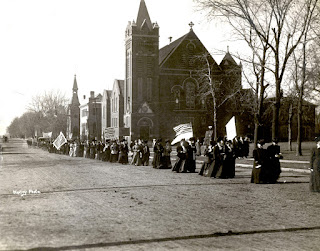We laughed at some of the things we found and the number of funeral notices and obituaries that she had in duplicate, triplicate, and more. Recipes cut out of a magazine that were never used and every birthday, Christmas, or Mother's Day card she had ever received! I cried when we talked about our memories or saw items that had belonged to our grandparents. We talked about the school books, some dating to the late 1800's that now were moldy and not salvageable. And I was saddened by the huge number of photos, mostly unlabeled, that will one day be tossed because we can't identify the subjects.
It was an emotional week. And now mom's 93 years are downsized even more, from a 10 x 20 unit to a 10 x 10 unit.
For all of us, I ask that we label photos or cherished family items for future generations so they will survive and be enjoyed beyond our time. I wrote the following post a couple of weeks ago, and today it seems most appropriate:
Do you have an item from one of our relatives or ancestors that makes you smile or remember a special time?
I have a few small items from my grandparents, and even a couple from great-grandparents. A vase. A teapot. A dish. A violin. None are worth any large sums of money. Most were items that they used, that I remember, that I saw in their houses.
My Grandma Linn (Maude Edith Olofson) was known to some to be a difficult woman with a temper and a memory to match. I never saw any of those characteristics. To me, Grandma was a great cook (although the only way I could stomach the lutefisk was to smother it with white sauce and dump a ton of cinnamon on it), a left-handed crocheter, a lively piano player, and a hugger who always wore shirtwaist dresses and had her short curly hair perfectly arranged.
Grandma and Grandpa had 5 sons, then 2 grandsons, and then me. Maybe there was a special bond between us as she had to be a bit weary of seeing nothing but males in the family. But whatever the reason, I always had a good time visiting with Grandma and always loved eating anything she cooked.
We all know about Grandpa's bleeding ulcers and how he suffered with them. There were times he spent at the Veteran's Hospital for treatment of his ulcers. And during one of those stays, when I was 11 or 12, I spent a couple of days keeping Grandma company.
At that time, we lived just a block away. Grandpa and Grandma lived in a one-story, two-tone bungalow at 1430 5th Avenue. We lived at 1464 Fourth Street in a two-story house built in the late 1800's that had a horse barn/garage behind the house, complete with steps to a second floor attic. That was where all of our toys were stored, where we often played. It was just a short walk through the alley, around the corner, past the World War I shell-shocked man and a few good friends' houses to reach Grandpa and Grandma's house.
I had many times alone with Grandma, many times that I wish now I had asked her questions about her own parents, about traditions, about the photos she had on the mantle. How I wish I had asked her about life on the farm, about her memories of her grandparents, about how she and Grandpa fell in love. But I didn't.
When I stayed with Grandma, she sat me down in the kitchen at the back of the house, next to a large bucket of apples. We were going to make jars and jars of applesauce, and my job was to use the apple corer/peeler to start the process. We had a great time, a special time, that I will always cherish.
And I have that apple corer/peeler today. Every time I see it, I think of Grandma and the time we spent, just the two of us, making applesauce.
 |
| Grandma's Rusty Apple Corer |
If you ask my siblings, they will tell you that I just might border on being a hoarder. I would not agree. But what I would say is that these items, when gone, are gone forever. Photos. Vases. Military uniforms. Recipes. Family Bibles. Please don't toss what you have. If you don't have anyone in your family willing to take these treasured family heirlooms, I'm here. And I promise to take good care of our family history in all of its forms and do my best to pass it on to the next generation.
Want one of your items displayed on this blog? Send me a photo and a story and we can all enjoy. I've spent alot of time these past few days while writing this post, just thinking about my Grandma. And each time I did, I smiled, just remembering that one special day, but also so many special days we had, whether playing cards, listening to her play the piano, or eating her great food.
I hope that you have an item that brings back those same kinds of memories.
















